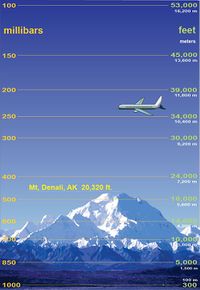Atmospheric pressure
It is the force exerted on a surface by the air above it as gravity pulls it to earth. Atmospheric pressure is commonly measured with a barometer. In a barometer, a column of mercury in a glass tube rises or falls as the weight of the atmospheric changes. Meteorologists describe the atmospheric pressure by how high the mercury rises.
Atmosphere (atm) is a unit of measurement equal to the average air pressure at sea level at a temperature of 15 degrees Celsius (59 degrees Fahrenheit). One atmosphere is 1.013 milibars, or 760 millimeters (29.92 inches) of mercury.
Atmospheric pressure is also called the barometric pressure and varies with elevation above sea level. Also, at a given place it varies slightly from time to time because of changes in meteorological conditions.
References
- Fluid Mechanics with Engineering Applications by Robert L. Daugherty, Joseph B. Franzini, E. John Finnemore (p.29)
